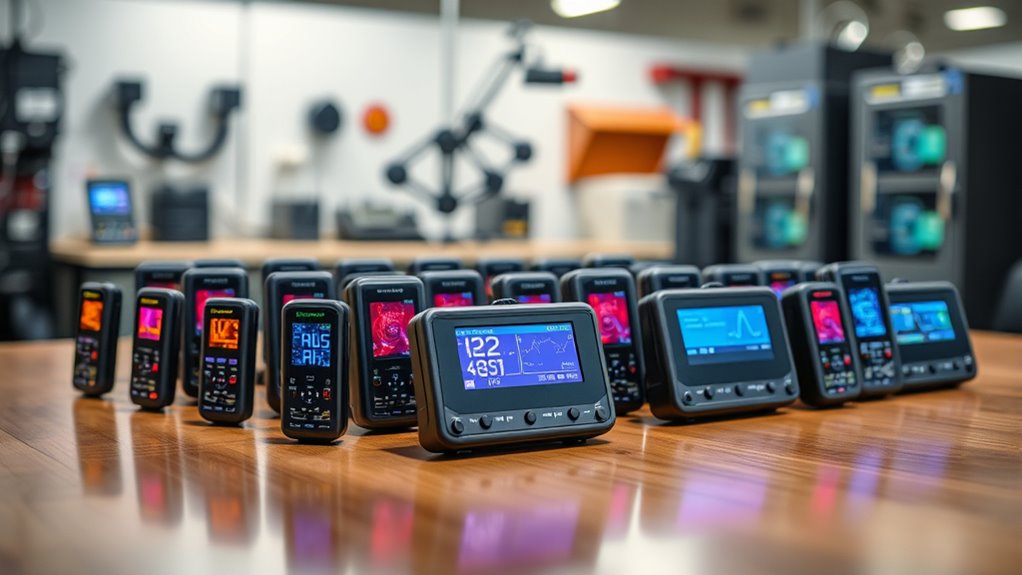If you’re looking for the best magnetic field detectors of 2025, it’s essential to find a reliable tool that accurately measures EMF. I’ve researched various options, including user-friendly meters with smart alerts, high sensitivity, and dual measurement capabilities. Some significant contenders include the Fluke 323 Clamp Meter and the GQ EMF-390. To make the best choice for your needs, you’ll want to take into account factors like detection range and build quality. There’s more to discover about these detectors!
Key Takeaways
- Evaluate the detection range of each device, focusing on specifications that cover both low and high frequencies effectively.
- Consider sensitivity and resolution to ensure accurate readings in milliGauss or microTesla for your specific needs.
- Look for user-friendly interfaces with backlit displays for better visibility and ease of use in various environments.
- Assess battery life and power options, including rechargeable devices for convenience and sustainability.
- Review pros and cons of popular models, considering user feedback on reliability and accuracy for informed purchasing decisions.
Fluke 323 Clamp Meter for Electricians
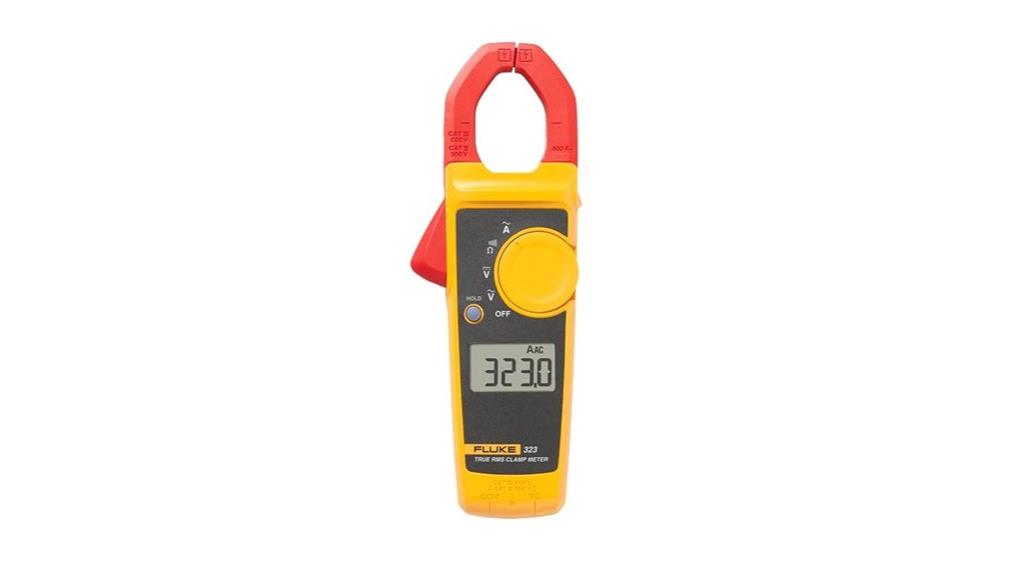
If you’re an electrician looking for a reliable tool, the Fluke 323 Clamp Meter is an excellent choice. It measures AC current up to 400 A, along with AC/DC voltage and resistance, providing true RMS sensing for accurate readings. Its compact design fits well in tight spaces, making troubleshooting a breeze. The backlit display is handy for low-light situations. Users appreciate its reliability and appreciate the audible continuity sensor for checking circuit conductivity. While some mention lead quality issues, the overall value and performance make it a must-have for both professionals and DIY enthusiasts. It’s definitely worth considering!
Best For: Electricians and DIY enthusiasts seeking a reliable and compact clamp meter for accurate electrical measurements.
Pros:
- True RMS sensing provides accurate readings for both linear and non-linear loads.
- Compact design allows for easy use in tight spaces and general troubleshooting.
- Backlit display enhances usability in low-light conditions.
Cons:
- Does not measure DC current or high ohm values.
- Some users report low quality leads included with the meter.
- Requires proper clamping technique for accurate amp readings, particularly with home appliances.
LATNEX MG-300 LF Magnetic Field Meter for EMF Home Inspections
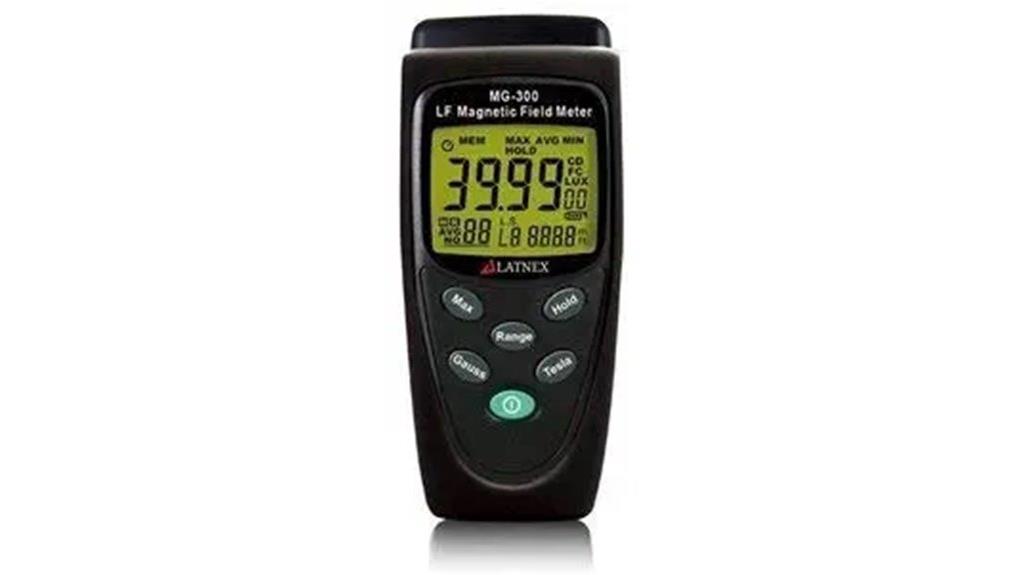
The LATNEX MG-300 LF Magnetic Field Meter is a must-have tool for homeowners who want to guarantee their living spaces are free from excessive electromagnetic fields (EMF). It effectively measures ELF EMF from 30 to 300Hz, helping you assess radiation levels around high-power lines and appliances. I love its user-friendly design and accurate readings, with a maximum display of 1999. You’ll find it reassuring to monitor various devices, especially since microwaves and smartphones often show high radiation levels. Plus, with a battery life of around 100 hours, it’s perfect for ongoing home inspections. Peace of mind is just a measurement away!
Best For: Homeowners who want to ensure their living spaces are free from excessive electromagnetic fields (EMF).
Pros:
- Easy to use with a simple design, providing accurate readings of EMF levels.
- Long battery life of approximately 100 hours, suitable for ongoing inspections.
- Offers peace of mind by monitoring radiation levels from various devices.
Cons:
- May show variability in readings throughout the day, which can be confusing.
- Some users reported difficulty detecting readings from smart meters.
- Requires measuring from different positions for more accurate results, which may be time-consuming.
Color Tree Handheld LED EMF Magnetic Field Detector

Looking for a reliable way to measure electromagnetic fields? The Color Tree Handheld LED EMF Magnetic Field Detector is a fantastic choice. It measures EMFs from 50 Hz to 20,000 Hz, helping you identify high-emission appliances. I love how portable and easy it is to use—just turn it on and point it at suspicious areas. The LED light scale is super responsive, making readings clear in any lighting. I’ve noticed significant spikes near devices like microwaves, and it even alerts with sound. Plus, it’s durable and affordable, making it perfect for both serious ghost hunters and casual users alike.
Best For: The Color Tree Handheld LED EMF Magnetic Field Detector is best for individuals concerned about electromagnetic exposure, including health-conscious users, ghost hunters, and casual home safety enthusiasts.
Pros:
- Portable and easy to use, allowing for quick assessments of EMF levels in various locations.
- Responsive LED light scale provides clear readings even in low-light conditions.
- Durable and affordable, making it accessible for both serious and casual users.
Cons:
- Limited to measuring EMFs within a specific frequency range (50 Hz to 20,000 Hz).
- Some users may find the sound alerts annoying, despite the option to silence them.
- May not provide detailed analysis or data logging capabilities for advanced users.
ERICKHILL EMF Meter, Handheld Digital EMF Detector
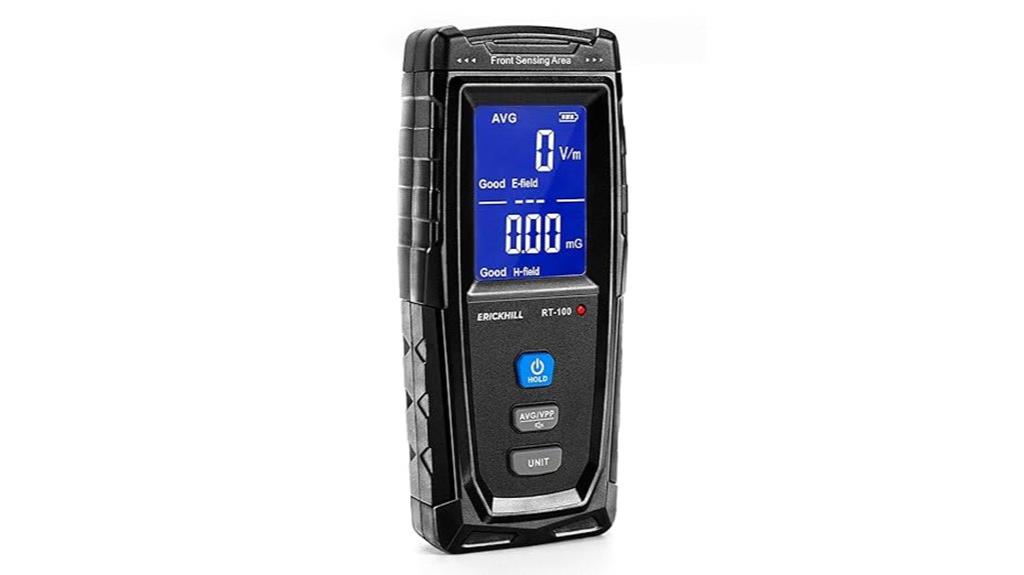
For anyone keen on monitoring electromagnetic fields, the ERICKHILL EMF Meter stands out as a reliable handheld digital detector. It measures electric fields in V/m and magnetic fields in mG/µT, making it perfect for home and office use. I appreciate its sound and light alarms that activate when EMF levels exceed safe limits. The LCD screen is clear, and the data hold function simplifies recording measurements. While some users noted fluctuations near electronics, I’ve found it effective for identifying high EMF sources. Just remember to test powered devices and maintain distance from strong EMF emitters for the best results.
Best For: Individuals seeking to monitor electromagnetic fields in home and office environments, including those interested in workplace safety and paranormal investigations.
Pros:
- Clear LCD screen and sound/light alarms for easy identification of high EMF levels.
- Data hold function allows for convenient recording of measurements.
- User-friendly design makes it suitable for general residential applications.
Cons:
- Readings may fluctuate near electronic devices, affecting accuracy.
- Limited to detecting electric and magnetic fields; does not measure RF signals.
- Additional information and a more comprehensive manual would enhance user understanding.
TESMEN Hound-200 EMF Detector: 3-in-1 Portable Electromagnetic Field Radiation Detector
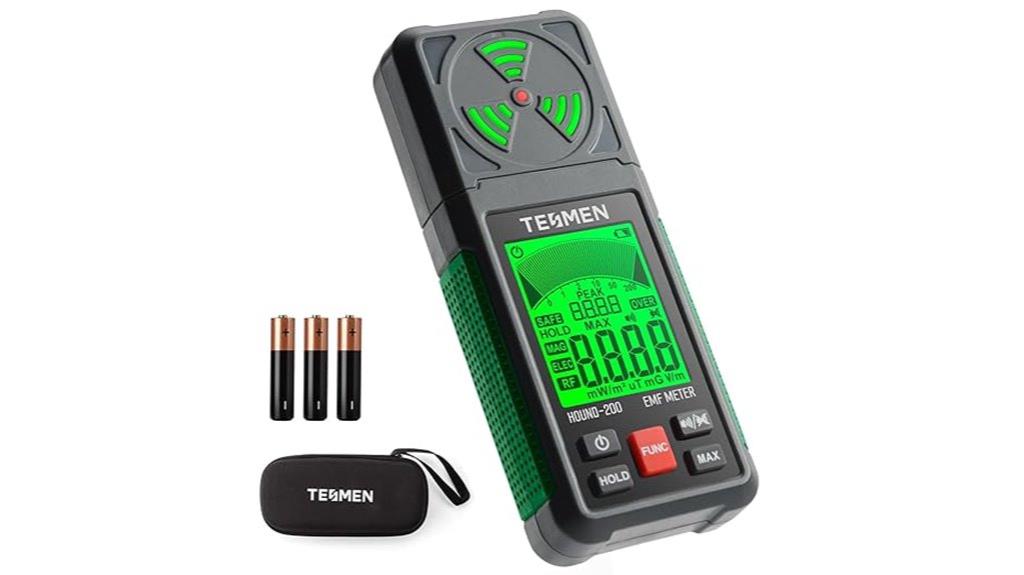
If you’re someone who wants to better understand electromagnetic fields in your environment, the TESMEN Hound-200 EMF Detector is a fantastic choice. This 3-in-1 portable device measures radiofrequency, electric, and magnetic fields, making it perfect for home inspections or even ghost hunting! I love the user-friendly design, featuring a clear LCD screen and color-coded alarms for field strength. It accurately detects emissions from household appliances, helping me make informed choices about my exposure. Plus, it comes with a handy storage case and customer support via Amazon. Overall, it’s a great tool for anyone concerned about EMF safety.
Best For: Individuals interested in monitoring electromagnetic fields in their homes, offices, or during ghost hunting activities.
Pros:
- User-friendly design with a clear LCD screen and color-coded alarms for easy interpretation of field strength.
- Accurate detection of RF, EF, and MF emissions from household appliances, aiding in informed decisions about EMF exposure.
- Includes a storage case and customer support for operational assistance via Amazon.
Cons:
- Instructions may be lacking, leading to potential confusion for some users.
- Does not measure ionizing radiation, limiting its scope for certain safety concerns.
- The color-coded display may not align with universal safety standards, which could lead to misinterpretation of results.
EMF Meter for Radio, Magnetic & Electric Fields Detection
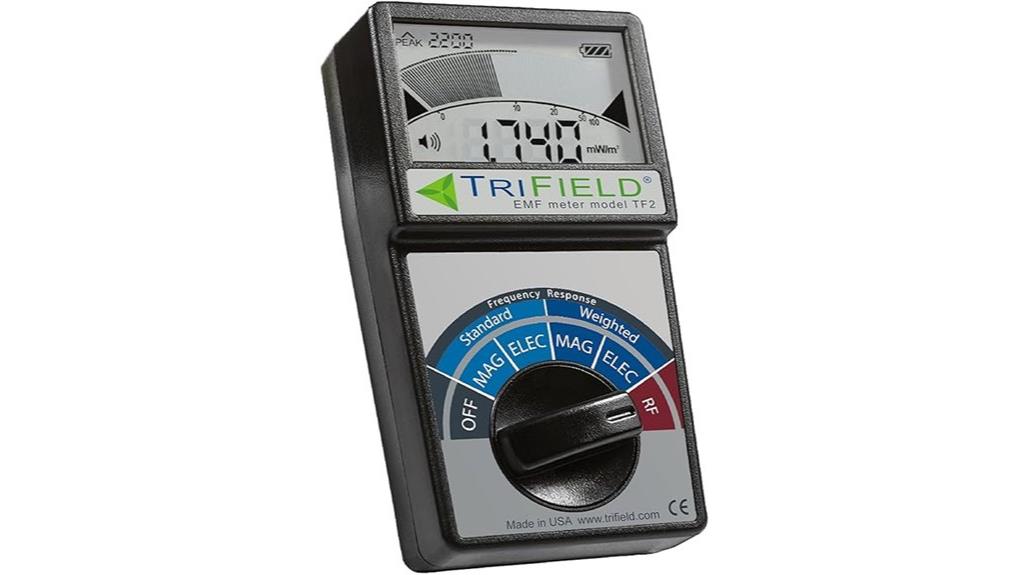
The EMF Meter for Radio, Magnetic & Electric Fields Detection is an essential tool for anyone concerned about electromagnetic field exposure in their daily environment. It detects magnetic, electric, and radio/microwave fields, showing levels from sources like cell phones and WiFi routers. I find its back-lit screen easy to read, even in dim light. Users often discover unexpected RF levels in their homes, prompting behavioral changes. While some buttons are a bit awkwardly placed, the device’s effectiveness, especially for tracking 5G exposure, makes it worthwhile. With a solid warranty and responsive customer support, it’s a smart choice for monitoring EMF levels.
Best For: Individuals concerned about EMF exposure from devices like cell phones, WiFi routers, and other electrical appliances.
Pros:
- Easy to operate with a user-friendly design and a highly visible back-lit screen.
- Effectively detects 4G and 5G EMF levels, enhancing awareness of RF exposure in various environments.
- Excellent customer support and a solid 1-Year Manufacturer Warranty provide peace of mind.
Cons:
- Some buttons are inconveniently placed within the battery compartment, which may be bothersome for users.
- Mixed reviews regarding accuracy from electrical engineers, though many users find it effective for personal use.
- Higher price point compared to cheaper alternatives, though it includes advanced features like 5G detection.
MIKEDE Magnetic Viewing Film, 4 x 4 Green Magnetic Field Display Film
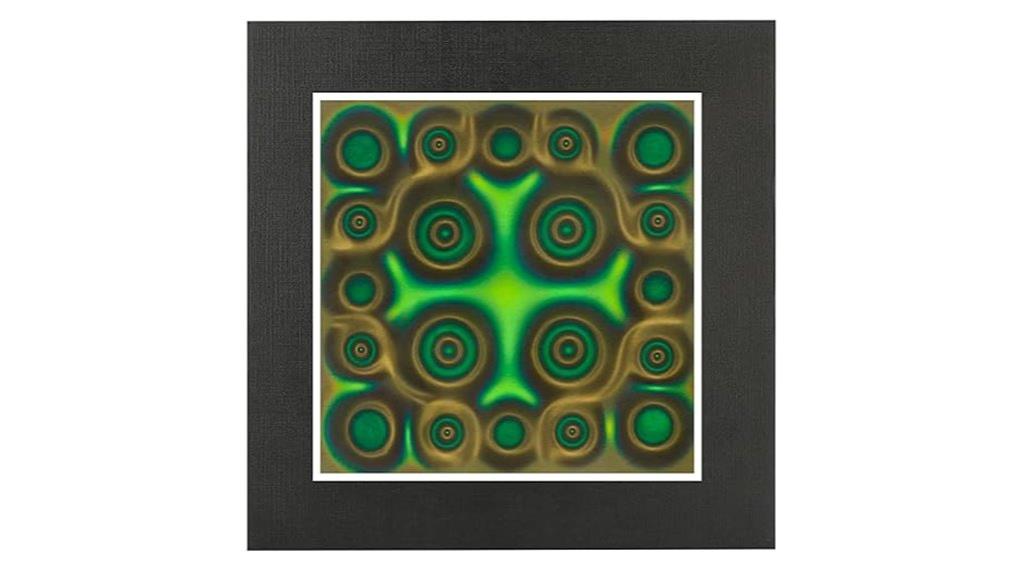
MIKEDE Magnetic Viewing Film stands out as an excellent tool for educators and students enthusiastic to explore the fascinating world of magnetism. This 4 x 4 inch film uses magnetic nanoparticles to display field modes and intensities, making it perfect for studying various magnets, including neodymium. I love how it visualizes magnetic field lines and levels of magnetization, enhancing classroom experiences. While it’s reusable and mess-free compared to iron filings, it’s less sensitive to weaker fields. Still, for strong magnets, it provides an engaging way to understand magnetic properties. Overall, it’s a valuable addition to any educational toolkit!
Best For: Educators and students looking to engage with and visualize magnetic fields in a classroom setting.
Pros:
- Mess-free alternative to traditional iron filings for visualizing magnetic fields.
- Reusable and automatically recovers after use, providing long-term value.
- Enhances educational experiences by visualizing magnetic field lines and magnetization levels.
Cons:
- Less sensitive to weak magnetic fields, limiting its effectiveness with certain magnets.
- Not as detailed for smaller magnets, such as those found in business cards.
- Struggles to display magnetic fields around antennas or electric motors compared to other methods.
EMF Detector for Electromagnetic Radiation Field
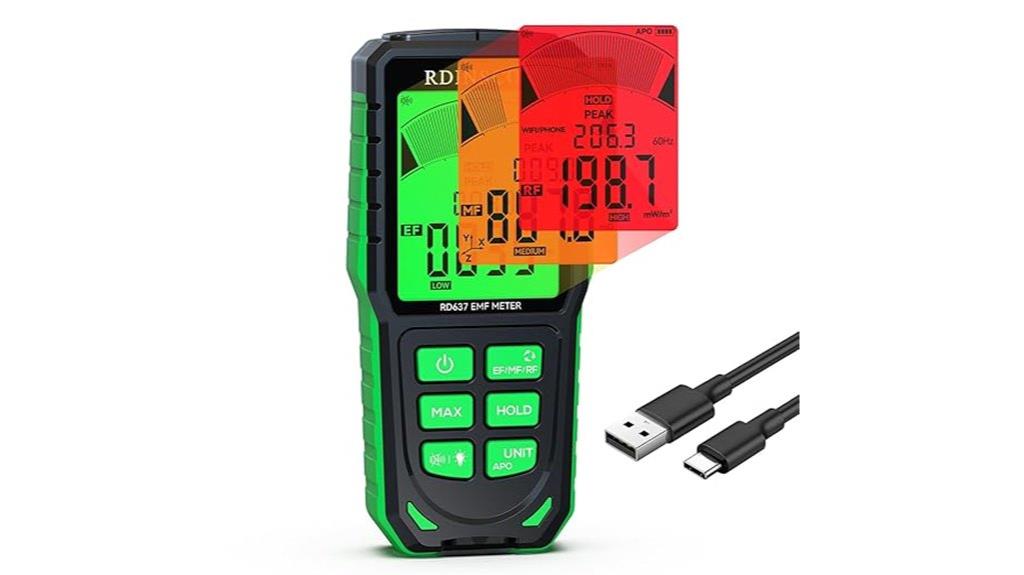
For anyone concerned about electromagnetic radiation exposure, the EMF Detector stands out as an essential tool. It measures three types of radiation: RF, microwave, and mixed electromagnetic waves, making it perfect for home, office, or even ghost hunting. The tri-color LCD screen clearly indicates radiation levels—green for safe, orange for caution, and red for danger. I appreciate its portable design and high-precision sensor, which guarantees accurate readings. Plus, I can disable the piezoelectric speaker for quiet use. Overall, this device is invaluable for monitoring EMF levels from common household appliances and guaranteeing a safer environment.
Best For: Individuals concerned about electromagnetic radiation exposure in their home or work environments, as well as ghost hunters seeking insights into electromagnetic fields.
Pros:
- High-precision sensor with ±5% accuracy for reliable readings of various electromagnetic radiation types.
- Portable design and easy-to-read tri-color LCD screen for user-friendly operation.
- Ability to disable the piezoelectric speaker for quiet usage while retaining settings after power-off.
Cons:
- Requires a non-rechargeable 9V battery, which may entail additional costs for users.
- Some users report inaccurate readings, including constant alerts or false positives.
- Weaker EMFs may need closer proximity for accurate measurement, limiting effectiveness.
EMF Meter Magnetic Field Detector for Home and Outdoor Inspections
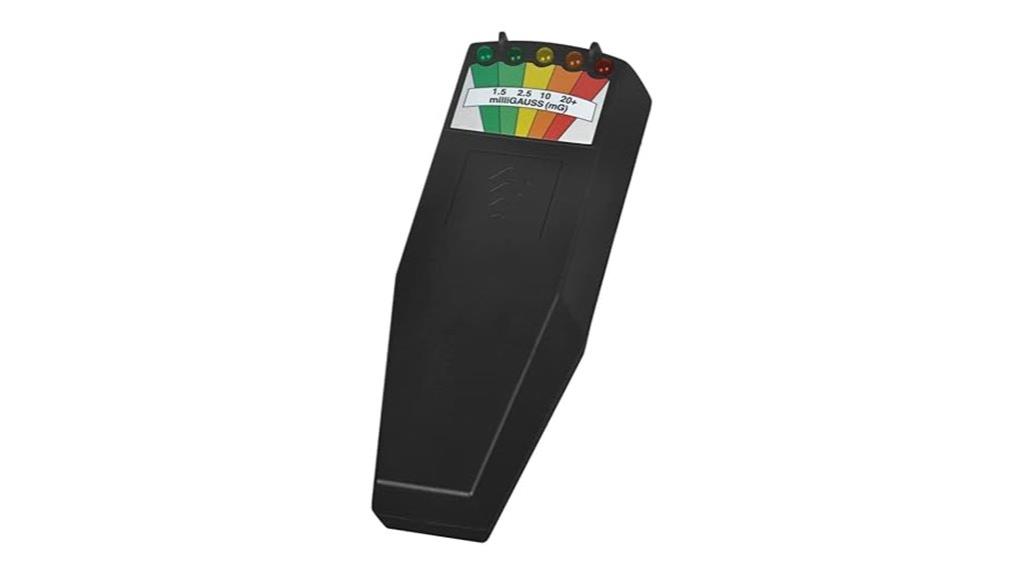
If you’re looking to guarantee a safe environment at home or outdoors, the EMF Meter Magnetic Field Detector stands out as an essential tool. This compact device measures electromagnetic fields, helping me identify high radiation levels from common appliances like microwaves and cell phones. With its 5 LED indicators, I can easily see readings in any light. It’s lightweight and portable, making it perfect for on-the-go inspections. While it doesn’t provide precise numeric readings, the affordability and effectiveness make it a great choice for beginners and families. I’ve found it invaluable for promoting health-conscious decisions in my everyday life.
Best For: This EMF Meter is best for beginners and families looking to promote health-conscious decisions by monitoring electromagnetic field levels in their home and outdoor environments.
Pros:
- Compact and portable design allows for easy transport and on-the-go inspections.
- User-friendly interface with 5 LED indicators for clear visibility of readings.
- Affordable option for those seeking basic EMF detection without complex readings.
Cons:
- Measures only magnetic fields, not electric or radio frequency fields, limiting its comprehensive use.
- Lacks precise numeric readings, which may not satisfy users seeking detailed data.
- Plastic construction may feel inexpensive, although it’s expected for a budget-friendly device.
Triplett ET30 Non-Contact Magnetic Field Detector – AC/DC/Permanent
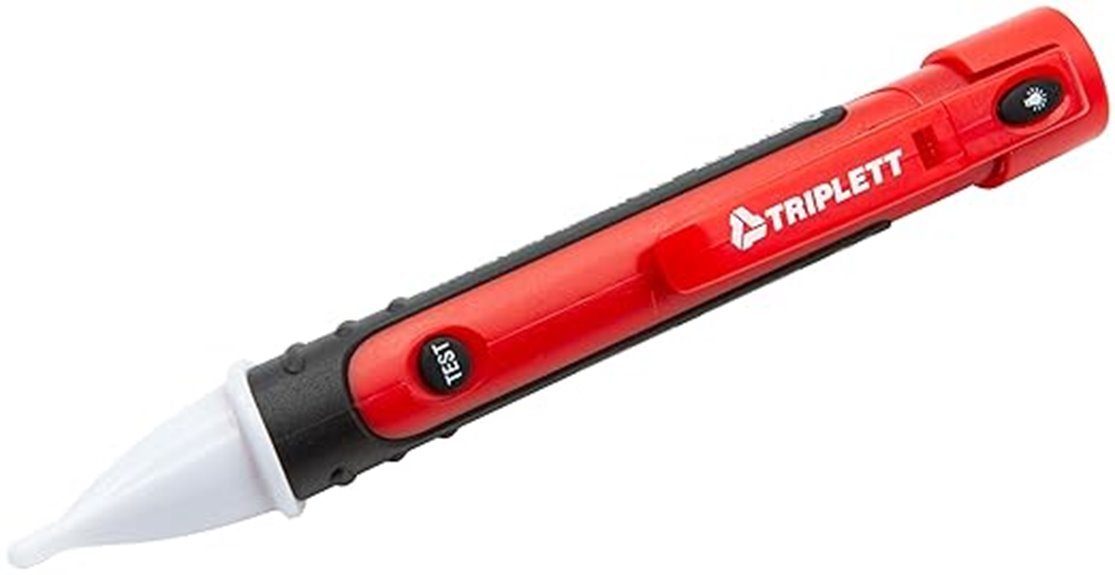
The Triplett ET30 Non-Contact Magnetic Field Detector is an excellent choice for technicians and DIY enthusiasts who need to quickly identify both AC magnetic fields and permanent magnets. It’s handy for testing solenoid valves and relays in various equipment. I appreciate its built-in self-test magnet and LED flashlight, which are useful features. However, I’ve noticed mixed reviews regarding its reliability. While some users find it effective, others report inconsistencies, especially with low to moderate DC fields. If you’re considering this tool, be aware of potential issues with battery installation and unclear instructions that might affect your experience.
Best For: Technicians and DIY enthusiasts who need a quick and portable solution for detecting AC magnetic fields and permanent magnets.
Pros:
- Built-in self-test magnet enhances usability and functionality.
- Includes an LED flashlight, providing additional convenience in low-light situations.
- Cost-effective tool for specific applications, such as testing solenoid valves and relays.
Cons:
- Mixed reviews regarding reliability, with some users reporting inconsistent performance.
- Issues with battery installation and unclear instructions can hinder user experience.
- Limited sensitivity to low to moderate DC fields, reducing its overall utility for some tasks.
LED EMF Meter Magnetic Field Detector
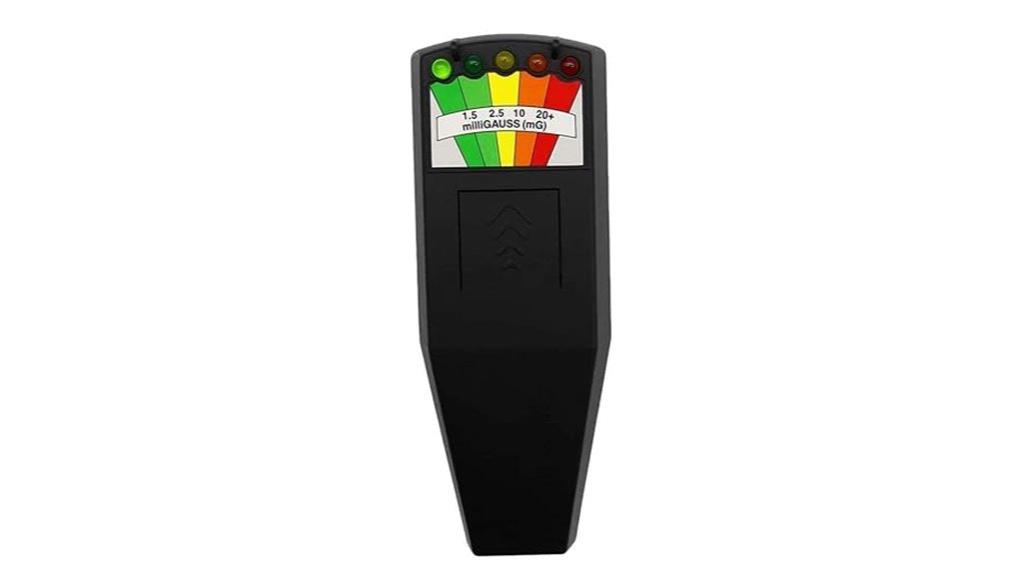
Ghost hunters and curious individuals alike will find the LED EMF Meter Magnetic Field Detector an invaluable tool, especially with its ability to measure electromagnetic fields from 50 Hz to 20,000 Hz. This handy gadget features a clear LED display and operates on a single 9V battery, making it user-friendly. I love how it detects mobile phones within 2 feet, helping me gauge my exposure to electromagnetic radiation. While some users report accuracy issues if the device isn’t upright, it’s perfect for exploring paranormal activities or checking household electronics. Just be mindful of its mixed reviews on build quality.
Best For: Ghost hunters and individuals interested in measuring electromagnetic fields for both paranormal investigations and general EMF awareness.
Pros:
- Easy-to-read multi-segment LED display for clear visibility.
- Detects electromagnetic fields from a wide range (50 Hz to 20,000 Hz) and mobile phones within 2 feet.
- User-friendly operation with a single 9V battery and simple on/off functionality.
Cons:
- Accuracy can be compromised if the device is not kept upright.
- Reports of rapid battery drain and malfunction after limited use.
- Mixed build quality reviews, with some users finding it feels cheap or experiencing unreliable button functionality.
TESMEN EMF Meter: 3-in-1 Portable Electromagnetic Field Radiation Detector
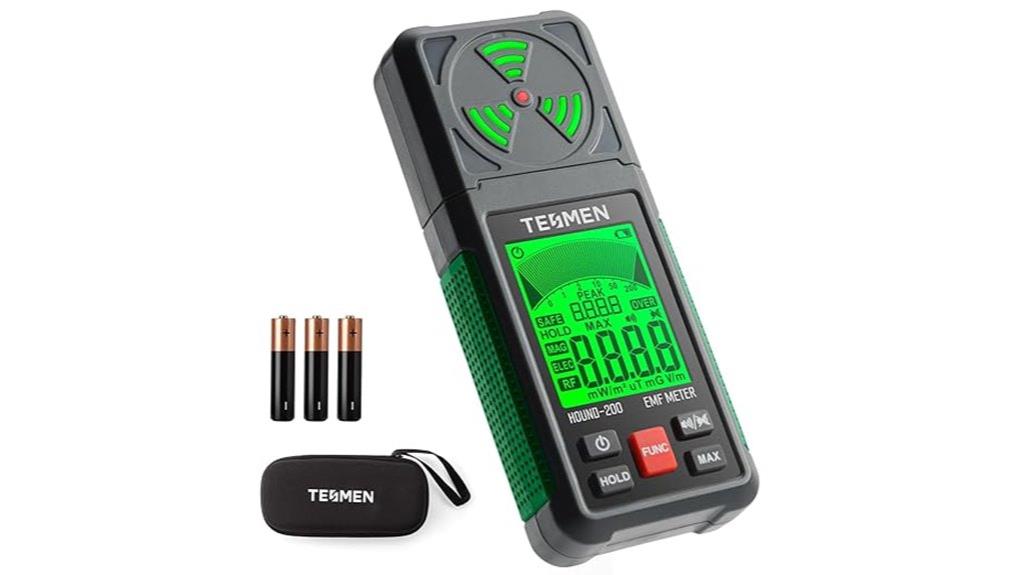
For anyone curious about electromagnetic fields or concerned about potential radiation exposure in their daily environment, the TESMEN EMF Meter is a game-changer. This 3-in-1 portable detector measures electric, magnetic, and radiofrequency fields, making it perfect for home inspections or even ghost hunting. I love its user-friendly design, featuring a clear LCD screen and audible alarms that alert me to radiation levels. Plus, it includes handy modes for monitoring WiFi and appliance emissions. While it’s not professional-grade, it provides accurate readings and valuable insights into EMF exposure, helping me make informed choices for better health.
Best For: Individuals concerned about EMF exposure and those interested in monitoring radiation levels in their environment.
Pros:
- User-friendly design with a clear LCD screen and audible alarms for easy monitoring.
- Versatile detection capabilities for electric, magnetic, and radiofrequency fields, including WiFi emissions.
- Provides accurate readings that help users make informed decisions about their exposure to electromagnetic radiation.
Cons:
- Not a professional-grade device, which may limit precision for specialized needs.
- Instructions may be lacking, leading to confusion for some users during setup and operation.
- Does not measure ionizing radiation, which limits its scope in assessing all types of radiation exposure.
GQ EMF-390 Multi-Field Electromagnetic Radiation Meter
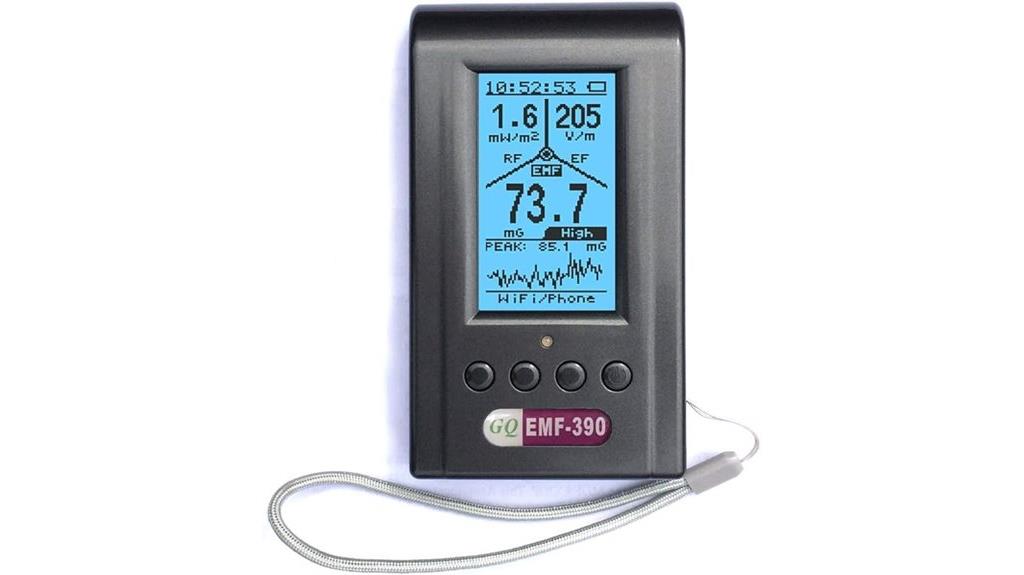
If you’re looking for a reliable tool to measure electromagnetic fields, the GQ EMF-390 Multi-Field Electromagnetic Radiation Meter is an excellent choice. This compact device combines EMF, ELF, and RF measurements, detecting signals up to 10GHz, including 5G. Its user-friendly interface and clear displays make navigation a breeze. I appreciate the built-in RF spectrum analyzer and data logging features, allowing me to monitor and document readings easily. While some users note fluctuations in accuracy, it remains a solid option for anyone wanting to understand EMF exposure. Just remember, context is key when interpreting your readings!
Best For: Individuals seeking to monitor and understand their electromagnetic field exposure, including casual users and concerned parents.
Pros:
- User-friendly interface with clear displays for easy navigation.
- Compact and portable design for convenient handling and regular use.
- Built-in RF spectrum analyzer and data logging features enhance monitoring capabilities.
Cons:
- Some users report fluctuations in readings, raising concerns about accuracy.
- Instructions may be unclear, leading to usability challenges for some users.
- Not suitable for individuals with severe electromagnetic sensitivity due to the device’s inherent emissions.
Magnetism Detector

The Magnetism Detector is an excellent choice for professionals in the steel industry, as it effectively measures residual magnetism in ferrous products. This pocket-sized, lightweight device indicates the degree and polarity of magnetism, operating simply by placing the base of the needle against the object. It reads from -20 to +20 gauss, making it easy to spot magnetism issues in welding equipment or stray fields in industrial settings. While many users find it reliable, be cautious around strong magnets, which can damage it. Overall, it’s perfect for those needing a general idea of magnetism presence without precise measurements.
Best For: Professionals in the steel industry and those needing to detect residual magnetism in ferrous products.
Pros:
- Easy to use and lightweight, making it portable for on-the-go measurements.
- Effectively indicates the degree and polarity of residual magnetism.
- Ideal for identifying magnetism issues in industrial applications and welding equipment.
Cons:
- Not suitable for measuring strong magnets, as it can lead to inaccurate readings.
- Some users report issues with the needle sticking or breaking during use.
- Limited precision for users seeking detailed decimal readings.
EMF Detector, Digital LCD EMF Meter for Indoor & Outdoor Inspection

Choosing an EMF Detector, like the Digital LCD EMF Meter, is essential for anyone serious about monitoring electromagnetic fields in both indoor and outdoor settings. This 3-in-1 rechargeable device features a high-sensitivity sensor for real-time analysis and displays readings on a vivid LCD. With dual measurement modes for magnetic and electric fields, plus temperature readings, it’s incredibly versatile. I love the smart threshold alerts that notify me when radiation exceeds safe levels. Its compact design and USB-C rechargeability make it convenient for home safety checks, ghost hunting, or outdoor explorations. Overall, it’s a reliable tool for anyone concerned about EMF exposure.
Best For: Individuals concerned about EMF exposure, including homeowners, workplace assessors, and paranormal investigators.
Pros:
- High-sensitivity sensor for accurate real-time radiation analysis.
- Smart threshold alerts provide safety notifications for exceeded radiation levels.
- Compact and rechargeable design enhances portability for various applications.
Cons:
- Some users report discrepancies in readings with non-electronic sources.
- May require occasional recalibration for precise measurements.
- Limited functionality for detecting low-frequency EMF sources compared to specialized equipment.
Factors to Consider When Choosing Magnetic Field Detectors
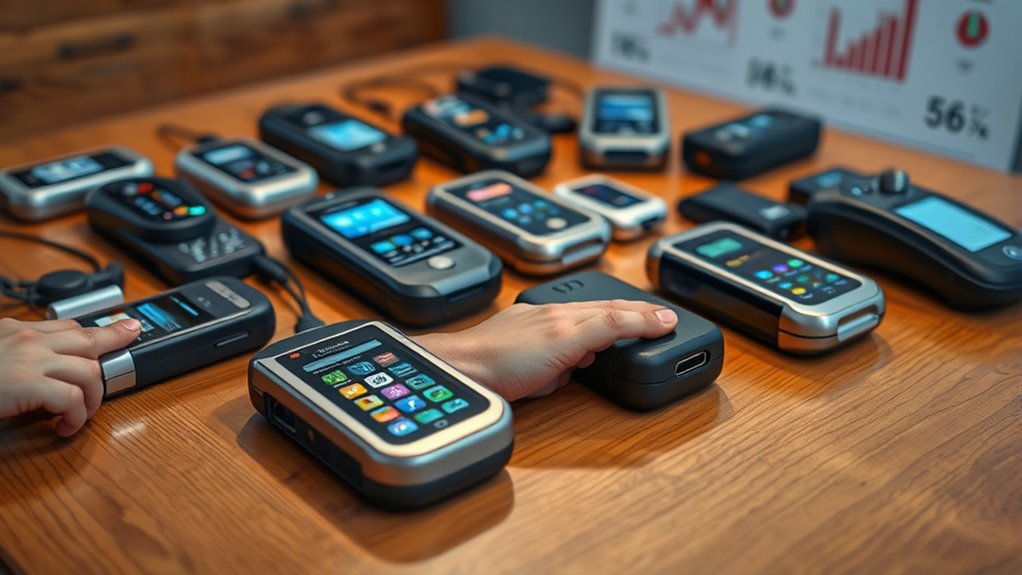
When I think about choosing a magnetic field detector, I focus on several key factors that can really impact its performance. Detection range, sensitivity, and usability are just a few aspects I consider essential for effective measurement. Plus, I always check accuracy and the power source options to guarantee I’m making the right choice.
Detection Range Specifications
Understanding detection range specifications is essential for selecting the right magnetic field detector. I’ve found that these specifications dictate the types of electromagnetic fields (EMFs) a meter can measure, typically ranging from low frequencies like 30Hz to high frequencies up to 10GHz. Most detectors measure EMFs in milliGauss (mG) or microTesla (µT), helping evaluate the intensity across different environments. Pay attention to the resolution, as it indicates the smallest change in magnetic field strength the device can detect, often at 0.1 mG or 0.01 µT for sensitive models. Additionally, some detectors offer dual measurement capabilities, evaluating both electric and magnetic fields, and the measurement bandwidth can greatly affect their effectiveness in capturing radiation.
Sensitivity to EMF Levels
While evaluating magnetic field detectors, it is crucial to take into account their sensitivity to electromagnetic field (EMF) levels. I find that the sensitivity is often quantified by a detector’s ability to measure EMFs across various frequency ranges, from as low as 30 Hz to 20,000 Hz. The accuracy of the readings can really depend on the device’s resolution, typically measured in milligauss (mG) or microtesla (µT). Some detectors even offer up to 2.5 readings per second, perfect for real-time monitoring. I also prefer devices with true RMS sensing technology, which provide accurate readings for fluctuating EMF sources. Finally, detectors with multiple sensors can greatly enhance overall sensitivity, making them more effective in identifying varying EMF levels.
Usability and Design Features
Evaluating magnetic field detectors goes beyond just their technical specifications; usability and design features play an essential role in how effectively I can use them. A backlit or color-coded display enhances readability in various lighting conditions, which I find vital. Compact and lightweight designs make it easy for me to carry the detector for home inspections or outdoor assessments. User-friendly features like automatic power-off, data hold functions, and audible alarms for high EMF levels greatly improve my experience. I also appreciate models that offer dual measurement modes, providing a more thorough understanding of electromagnetic exposure. Finally, durable materials and ergonomic designs guarantee the device withstands regular handling, making it comfortable to use in different environments.
Measurement Accuracy Considerations
When choosing a magnetic field detector, I find that measurement accuracy is one of the most critical factors to take into account. Look for devices that specify their accuracy ratings, often expressed as a percentage error, like ±2.5% at 50Hz or 60Hz. It’s also essential to understand the resolution; detectors that provide readings in milligauss (mG) or microtesla (µT) can differ considerably in precision, especially for low-level measurements. Pay attention to the frequency response range, as some detectors only measure specific bands, potentially missing emissions outside that range. Additionally, consider how proximity to the magnetic source influences readings; some detectors need a certain distance for accuracy. Calibration may also be necessary for consistent, reliable results in professional uses.
Power Source Options
After guaranteeing measurement accuracy, the next factor I consider is the power source for the magnetic field detector. I’ve noticed that these devices can be powered by single-use batteries, rechargeable batteries, or even USB power. While single-use batteries can be convenient, they often require frequent replacements, which can be a hassle and costly over time. I prefer rechargeable options since they save money and reduce waste. Some detectors also feature auto-sleep modes, conserving battery life when not in use. Portability is essential for fieldwork, so I look for lightweight, compact units. Finally, I always check the battery life and charging time to guarantee the detector meets my usage needs, keeping me ready for any task.
Application Versatility
Understanding the versatility of a magnetic field detector is essential for making the right choice, especially if you plan to use it in various settings. I recommend considering a detector’s ability to measure different types of electromagnetic fields, including electric fields (EF), magnetic fields (MF), and radiofrequency fields (RF). Look for devices that operate across a wide frequency range, ideally from 50 Hz to 20,000 Hz, to effectively assess emissions from household appliances and electronic devices. Additionally, check for useful measurement modes, like peak measurement and data hold features, which enhance usability. A clear visual display with color-coded backlighting helps interpret readings easily. Finally, prioritize portability and battery life for hassle-free fieldwork and inspections.
Build Quality and Durability
A sturdy magnetic field detector can make all the difference during field assessments. When I choose a detector, I prioritize build quality, as durable materials guarantee it can handle frequent use and potential drops. A lightweight design also catches my eye; it’s vital for carrying the device effortlessly during inspections. For industrial applications, I look for rugged construction, as these detectors need to endure harsh conditions, like dust and moisture. Additionally, a protective casing is important; it safeguards sensitive components and helps maintain accuracy over time. User feedback often emphasizes that a solid build prevents malfunctions, as flimsy designs can lead to inaccurate readings. Investing in a well-built detector is key for reliable performance and longevity.
Frequently Asked Questions
How Do I Calibrate My Magnetic Field Detector?
Calibrating your magnetic field detector is pretty straightforward. First, I make sure the device is placed in a known magnetic field or use a calibration tool that generates a specific field strength. Then, I adjust the settings until the readings match the expected values. It’s essential to follow the manufacturer’s instructions, as different models might have unique calibration processes. Regular checks keep my measurements accurate, ensuring I get reliable results every time.
Can Magnetic Field Detectors Measure Both AC and DC Fields?
Absolutely, magnetic field detectors can measure both AC and DC fields. I’ve found that many devices are designed specifically for one type, while others handle both. When I look for a detector, I check its specifications carefully. Understanding the difference helps me choose the right tool for my needs. If you’re like me and want versatility, aim for a dual-range detector to guarantee you capture all types of magnetic fields effectively.
What Is the Typical Battery Life of These Detectors?
When I look at magnetic field detectors, I often wonder about their battery life. Typically, I’ve found that it ranges from 20 to 50 hours, depending on the model and usage. Some detectors might even last longer if they’re used sparingly. It’s essential for me to check the specifications before purchasing, ensuring I’m getting a reliable device that won’t quit on me during important measurements. Battery life can make a big difference!
Are Magnetic Field Detectors Safe to Use Around Electronics?
When it comes to using magnetic field detectors around electronics, I’ve found that they’re generally safe. These devices operate at low frequencies and don’t emit harmful radiation. I’ve used mine near various gadgets without any issues. However, I always recommend keeping a bit of distance just to be cautious. It’s good practice to double-check the manufacturer’s guidelines to verify you’re using the detector correctly and safely around sensitive equipment.
How Do I Interpret the Readings From My Detector?
Interpreting readings from my magnetic field detector feels like reading the stars on a clear night—each flicker and glow tells a story. I look for consistent patterns, noting fluctuations in the numbers. A strong reading usually indicates a significant magnetic field source nearby, while lower numbers suggest a calmer environment. I remember to cross-reference with known sources, ensuring I’m not lost in the cosmic noise. Trust your instincts; they’ll guide you through the data.
Conclusion
In the world of magnetic field detectors, finding the right one can feel like searching for a needle in a haystack. However, armed with the insights from this guide, you’re well-equipped to make an informed choice. Whether you’re an electrician or simply curious about EMF levels in your home, there’s a perfect tool waiting for you. Remember, it’s not just about detecting fields; it’s about ensuring your environment is safe and healthy for you and your loved ones.
